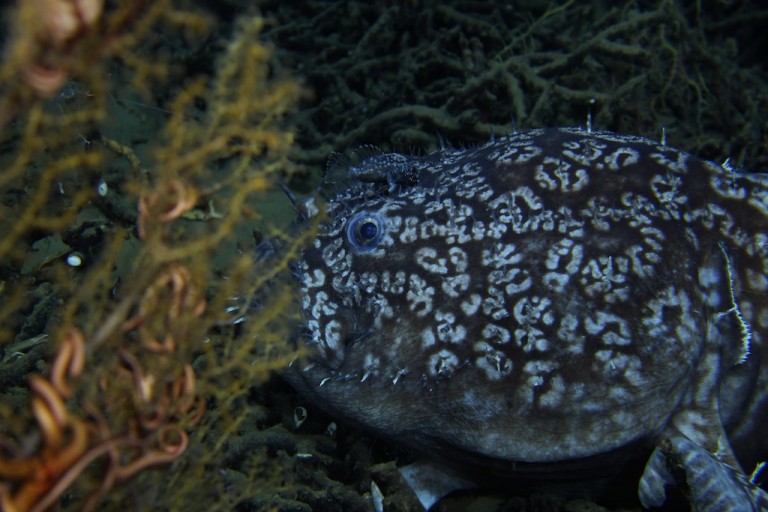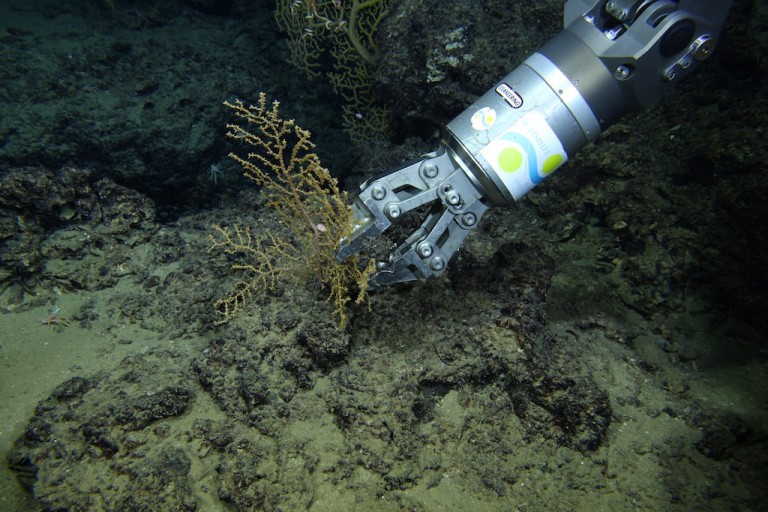Just when the seafloor scene becomes repetitive, something unexpected will come into view, reminding you of the mysteries of the deep.
The surprise today came around noon when the ROV Global Explorer MK3 encountered a deepwater goosefish (Sladenia shaefersi) resting on a mat of tubeworms between colorful stalks of corals. The fish is otherworldy and uncommon—it has a brown, bulbous body with white, leopard-like patterning, and a fleshy projection jutting off its head that advertises its classification in the anglerfish family. As of 2009, only three individuals had been caught worldwide. Dr. Chuck Fisher has seen goosefish in the past on submersible dives in the area, but it still was a rare treat for the rest of us.

As the ROV camera focused-in on the fish, we could also see a second, much smaller individual that appeared to be resting on the fish’s head. It would be easy to mistake the smaller fish for an offspring of the larger one. But it is more likely that the smaller fish is a male and the larger fish is a female. This is a known reproductive strategy in the life history of other deep-sea anglerfish species: once a male finds a female, it attaches itself and spends the rest of its life connected to her. The ROV spent only a few minutes watching the goosefish, and then it moved on to the next coral outcropping to continue the scientific work of the day.

Dr. Fisher’s team had a full day of ROV operations at site AT357, the furthest southwest position that will be visited during the remainder of this cruise. It is also where Dr. Ian MacDonald left video time-lapse camera on the seafloor during the previous leg of the cruise. The primary objective once again was to record images of every coral colony in this area. Samantha Berlet and Richard Dannenberg lead the dives, directing the pilots to about 60 different targets on the seafloor and controlling the high-resolution still camera to take the desired images. Back on land, Samantha and her colleagues will use visual recognition software to analyse each image and quantify changes in the colonies that have taken place since they were previously photographed. Our human perspective of a “long-term” study is only a sliver of time in the coral’s life. Scientists estimate that these deep-sea coral species can live from hundreds to thousands of years.
The ROV Global Explorer MK3 has a sophisticated suite of imaging systems that facilitate very detailed observations of coral colonies in their native habitat. The vehicle has three broadcast-quality, HDTV-resolution video cameras that record every dive. One camera provides a 10X zoom view; the other two cameras are mounted as a stereo pair that get recorded as side-by-side images for 3D video rendering. Researchers and pilots wear 3D glasses to view the high definition 3D video live on monitors in the ROV control lab during the operations. The 3D signal can also be displayed at other locations throughout the ship. Some scientists put on 3D glasses and watch the video in the ship’s library. The rocky areas and branching corals are ideal candidates for the depth-of-field view provided by the 3D video. It is also especially helpful during collections for the ROV pilot operating the manipulator arm.
Dr. Fisher’s team relies on the Global Explorer’s digital still camera. Customized software, a motorized zoom drive for the 18-55 mm lens, and high power LED panel lights allow the researchers to capture detailed images at depth.
In addition to imaging, today’s dive included collections of another species of coral, Paramurecia, for Danielle Young and Conall McNicholl who will run another set of experiments on this deeper-water species. Push cores of sediment were collected for Sara Kleindienst and Mauricio Silva in an area that appeared to have natural seeps as evidenced by white bacterial mats.
At the end of the dive, the ROV went back to the site of MacDonald’s video time-lapse camera to recover it back to R/V Falkor. The samples and camera returned safely to the ship just before sunset, leaving time for another multicore sediment sample to end a busy and productive day.
